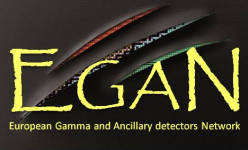Speaker
Aurore Dijon
(GANIL)
Description
Excited states in a wide range of neutron rich nuclei around 68Ni have been studied using the EXOGAM array in coincidence with the VAMOS large acceptance spectrometer. The nuclei of interest were produced via multi nucleon transfer reactions in inverse kinematics using a 238U beam at an energy around 16% above the Coulomb barrier. In nuclei located below 68Ni, a recent experimental work revealed the possible appearance of a third island of inversion. A sudden increase of collectivity from 62Fe to 64Fe has been observed and indicates a weakness of the N=40 subshell gap. The comparison with shell model calculations, show that the neutron g9/2 and d5/2 orbitals become active below N=40 when removing protons from the 68Ni core. Above 68Ni, the first 7/2\- state observed in the structure of copper isotopes can be interpreted as one proton in the p3/2 orbital coupled to the first 2+ state in nickel isotones. Similarly, as suggested by D. Pauwels et al, a one proton hole in the f7/2 orbital coupled to the first 2+ state in nickel isotones should induce some collectivity in the cobalt isotopes. The question of the nature of the low lying states in neutron rich Co isotopes therefore arises and it is the focus of this paper to discuss the structure of some nuclei in this mass region. To this end, we performed two complementary experiments at GANIL which aimed at 1) measuring the evolution of collectivity and 2) searching for the presence of isomers. In the first experiment, the lifetimes of the low-lying 9/2\- and 3/2\- excited states in 63,65Co have been measured for the first time using the recoil-distance Doppler shift method and the associated B(E2) transition probabilities extracted. The data from this experiment have been compared with large scale shell model calculations performed with the ANTOINE code using different interactions. A detailed analysis of the wave functions describing the states of interest in cobalt isotopes toward N=40 will be discussed. The results seem to indicate a different behavior as compared to what has been observed in the iron chain. The main goal of the second experiment we performed in this mass region was to perform the combined prompt and delayed gamma-ray spectroscopy using EXOGAM and the VAMOS spectrometer in a solenoid configuration. Preliminary results on new isomers and prompt decays will be presented.
Primary author
Aurore Dijon
(GANIL)

